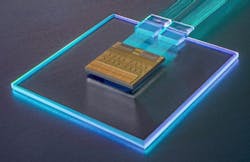IBM joins project to develop 3D chip-to-chip and intra-chip photonic interconnects to speed data throughput
ARLINGTON, Va. – Photonics and integrated circuits specialists from International Business Machines (IBM) Corp. in Armonk, N.Y., will help develop 3D chip-to-chip and intra-chip photonic interconnects to speed military information throughput and reduce vulnerability to electromagnetic interference under terms of a $9.1 million contract announced on Wednesday.
Officials of the U.S. Defense Advanced Research Projects Agency (DARPA) in Arlington, Va., are asking IBM to participate in the Heterogenous Adaptively Produced Photonic Interfaces (HAPPI) program.
HAPPI focuses on high-density 3D chip optical links and the ability to provide several routing planes within a photonic integrated circuit or photonic interposer to speed information throughput. IBM joins North Carolina State University in Raleigh, N.C., the RTX Raytheon segment in Arlington, Va., and SRI International in Menlo Park, Calif., on the HAPPI optical computing project.
The four research organizations will pursue enabling technologies in optical computing by performing hardware demonstrations of low-loss, high-density optical interconnects for 3D chips using a scalable manufacturing process that is compatible with microelectronics.
Fiber coupling
The project also emphasizes vertical connections between routing layers that can traverse substrate thickness, and surface methods for coupling light from one photonic chip to another. Chip-to-fiber coupling and chip-to-chip edge coupling are not part of the program.
DARPA researchers are asking IBM, North Carolina State, RTX Raytheon, and SRI to create optical interfaces that are robust to typical microsystem misalignments due to fabrication and assembly variability, especially for large link arrays that span reticle-or wafer-scale systems.
The four organizations also will pursue robust-by-design or adaptive interfaces capable of environmentally and mechanically stable optical performance, with compatibility with standard microelectronics manufacturing and assembly flows.
IBM, North Carolina State, RTX Raytheon, and SRI will take-on challenges of coupling to a photonic integrated circuit with demonstrated optoelectronic sources, amplifiers, modulators, multiplexers, filters, detectors, and other electro-optical components. The operating wavelengths may be within the visible or near infrared optical bands.
Information transmission
The HAPPI program aims to create a 1000x increase microsystem information transmission density by exploiting photonic signaling. The ability to move and process information efficiently throughout a microsystem requires signal routing technology with high data rates and dense access points.
Photonic links are sparse within the microsystem due to planar optical routing geometries. Increasing the density of photonic links requires moving to 3D optical routing within the chip and between chips, and will enable information delivery when and where it is needed in applications such as signal processing, free-space communications, remote sensing, digital compute, and atomic sensing.
The HAPPI program is a 36-month, two-phase program, with a base and an option period. The 18-month first phase will prove the feasibility of 3D routing in integrated photonics, while the 18-month second phase will scale the density and prove the manufacturability of the 3D routing platform.
For more information contact IBM online at www.ibm.com; North Carolina State University at www.ncsu.edu/research; RTX Raytheon at www.rtx.com/raytheon, SRI International at www.sri.com, or DARPA at www.darpa.mil/research/programs/happi-heterogeneous.
About the Author
John Keller
Editor-in-Chief
John Keller is the Editor-in-Chief, Military & Aerospace Electronics Magazine--provides extensive coverage and analysis of enabling electronics and optoelectronic technologies in military, space and commercial aviation applications. John has been a member of the Military & Aerospace Electronics staff since 1989 and chief editor since 1995.
